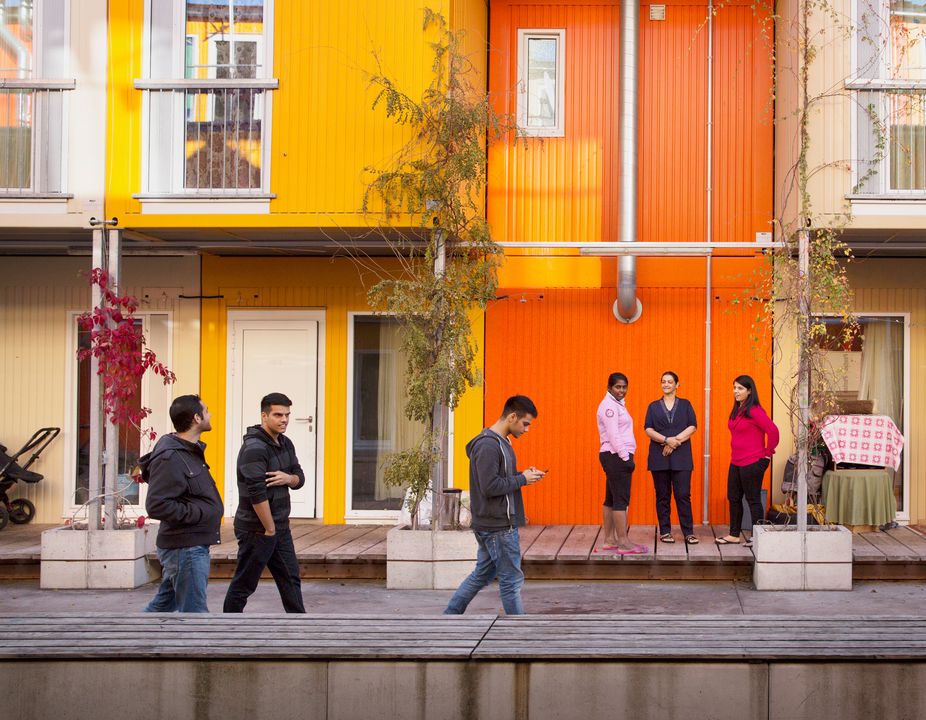It's all happening in the west of Zurich as a new urban space takes shape around Vulkanplatz near the Altstetten train station. The area is being transformed by an innovative project for the interim use of living spaces known as 'FOGO'. It combines temporary accommodation for refugees with student housing, space for businesses and cultural activities. A new way for people to work and live together.
It all started because of a triad of circumstances. The municipal foundation Einfach Wohnen, which was established in 2013 with the aim to create affordable eco-homes and office spaces, was looking for a plot of land to realise its vision. At the same time, the Asylum Organisation Zurich (AOZ) was forced to transfer its first temporary housing development based in Leutschenbach, Zurich to another location as it did not have permission to use the site beyond 2018. Hence, the AOZ was also looking for a plot of land. The third party in search of affordable rental accommodation for students was the Zurich-based youth housing network Juwo. This fortuitous set of circumstances gave rise to the innovative FOGO project. FOGO provides housing for low-income families while facilitating the coexistence of different communities: refugees, young people in education or training, commuters who park their cars on the periphery of the area and residents of the quarter.
This has led to students and asylum seekers living under the same roof. Shared housing is a pragmatic solution as both groups struggle to find affordable housing in Zurich. In addition, students as well as asylum seekers usually need temporary housing. Students move away after graduating or, in some cases, after a couple of semesters. Depending on their immigration status, refugees will eventually move into their own homes. The number of asylum seekers in need of accommodation is also constantly changing. If the AOZ needs to accommodate fewer people in a given period, Juwo can take on the vacant apartments. Such shared housing offers valuable flexibility. FOGO is not just a place to live. It is also an inspiring place to work, where innovative restaurants, small businesses, cultural activities and training venues thrive. It provides a space for people from all backgrounds and walks of life with different future prospects. Altogether they shape FOGO, a kind of city within a city, which has become a dynamic meeting place and innovation hotbed.
Redesigned housing to facilitate integration
Coexistence 2.0 – Zurich enters a new era of asylum policy. FOGO stands for an innovative way of housing refugees in Switzerland based on an asylum policy that seeks to include refugees in public spaces and civil society. The 2019 Integration Agenda calls for better ways to integrate recognised refugees, temporarily admitted persons and asylum seekers, which includes facilitating interaction with local communities. For refugees to integrate successfully, they need to be in close contact with their host communities. According to Thomas Kunz, Director of the AOZ, integration does not take place in isolated areas. He believes that the location of housing largely determines how well refugees integrate. In order to be appreciated and accepted by society, refugees need to be visible. Communities are created through contact and interaction, which are essential to refugees who are in the process of settling in and familiarising themselves with a society that is foreign to them.
Thomas Kunz also points out that the integration process touches on many different aspects of life: employment, housing and leisure activities. For him, Coexistence 2.0 offers refugees a place to interact in various spheres of life making FOGO a unique and inclusive space.
Community-building requires momentum
However, does FOGO’s newly created sense of belonging actually correspond with what refugees searching for a new home strive for? Ethnologist Georg Elwert points out that migrants often prefer to mingle with their own ethnic communities during the integration process as this gives them a common point of reference. In the initial stages of settling in, refugees tend to interact with people from the same ethnic backgrounds. This clearly creates a little piece of home within a foreign environment and helps them cope with the uncertainty and stress that come with migration. However, refugees who retreat completely into their own ethnic communities risk compromising their abilities to integrate into mainstream society. FOGO creates a sense of belonging for different population groups. Residents of the quarter are just as present as international employees of large companies in the neighbourhood, asylum seekers from the same background and Swiss as well as international students.
FOGO does not accommodate specific groups, it brings together individuals with life stories, ideas and needs that may or may not be similar. It is a place where people can meet and interact with each other, should they want to. Thomas Kunz believes that this freedom of choice and the relaxed nature of social interaction are the essence of FOGO. This is not a place to create and define communities once and for all. "We don’t want to create socio-cultural cohesiveness," he says. FOGO is characterised by diversity, openness, change and momentum, which give the place its special atmosphere – that of normality. The idea is not to make FOGO an artificial island, but for people to lead a normal life. "It's like any odd flat share", a young student describes his new home shortly after moving in – a ringing endorsement of the AOZ's vision.
This article was written by Sabine Binelli on behalf of the Federal Commission on Migration (FCM) for 'terra cognita' – the integration and migration magazine.


